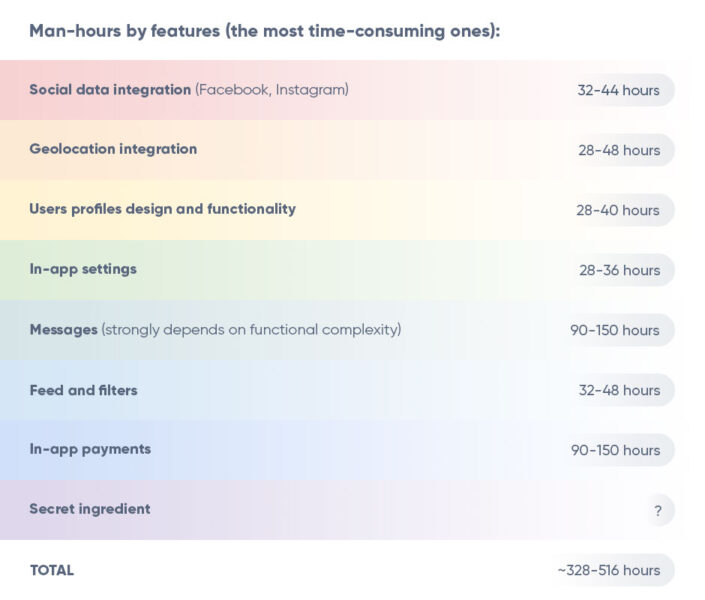It is difficult to find a more relevant topic than dating at any time. Now that almost all areas of activity go online, we need to look for ways to organize platforms where people can communicate, find sympathies and invite each other to meet. Meanwhile, dating requires more delicacy and careful consideration of security issues, privacy, as well as the ways of user activity encouragement. Those who will take a risk and create an application similar to Tinder or another dating app, as practice shows, can count on their share of $3 billion annual dating services revenue.
What is a Match Making App?
A dating application is much like a social network while it includes most of its key elements:
- Registrations system.
- Account creation.
- Sending/receiving instant messages.
- A profile photo and a profile description.
Many dating sites and applications even use the design similar to those of social networks. One would assume that dating app development is the same as in a small social network startup. However, there are several significant differences in dating applications, such as geolocation and matchmaking, which make them a special field for developers’ and UX designers’ activities.
Security Concerns
Dating applications should be much more careful about verifying user profile data and guaranteeing that all their correspondence and personal data published on the site will be kept in secret. There is nothing more terrible for any Tinder clone than the leakage of user data and their subsequent use, for example, for advertising purposes. Analyzing the existing analogs of Tinder, we collected various recommendations that would help to avoid such a deplorable situations.
- Safe social network integration and geolocation. Yes, these are essential features for both providing quick access to your app functions and ensuring the real identity of the user. The more social networks will be linked to the profile, the better, but do not forget that all the users’ data won’t be revealed to any of the third-party services. Here, the social network integration and geolocation services are the bottlenecks of a dating app like Tinder, so be careful with them.
- Invite-only scheme. This will definitely limit the number of your customers and make the marketing of such a product much more difficult, but all this will be balanced by a high level of trust from users and the greater conversion.
- Profile verification encouragement. Fancy a demo of your app with a limited set of features is available for everybody, but to get access to the most interesting features one should verify an account with a social network signup or in any other way.
Ice-Break Your Audience
Not every person is ready to fill in the profile right after the registration, start sharing their thoughts, communicate and invite others to meetings. According to statistics, it is men who show more activity in using a match making app, while girls rarely write first (source). Knowing the characteristics of the audience of your future application, you can develop a strategy for effectively giving a start for user activity.
- Add ice-breaker questions. When it is hard to start communication and find a proper topic for conversation, these questions will be quite advantageous. Help your users to come up with an occasion to communicate and understand if they are suitable for each other, and not just give them one more messenger app.
- Let women mail first. According to the same statistics, women receive incommensurably more messages than men but do not try to initiate contact themselves. There is a game in one gate, which does not contribute to the communication. In order for girls not to keep silent some applications (Bubble app, for instance) allow to send them messages only after they respond to sympathy. This speeds up the process of searching for men and encourages girls to make decisions.

Geolocation and Filters
Definitely, people search for companions nearby, and not the ones from different continents. You are to give them an opportunity to decide how distant sympathies they are ready to find. For this, both geolocation and filter features are required: the former is for an automatic check-in, the latter is for finding the best match for interests, beauty, or other preferences. Don’t forget to ask users for permission for using the geolocation information during the initial login.
The Key Features of Mobile Dating Apps
You’re a creator and, depending on what you want to bring to your customers, feature selection is a personalized process. Still, there’s a must-have toolkit you need to create a Tinder-like app:
- Instant messaging: Your clients should be able to start communication within the dating app so that they could stick to the platform.
- Interaction with a personal profile: Likes, page visits, checking preferences, or commenting – a user should have a possibility to demonstrate interest by acting upon a profile.
- Location sharing: Allow people to choose their partners based on geographical proximity.
You can also add any bells and whistles to build a dating app with a unique value offer. From photo filters to video conferencing, pick advanced features based on user research and your dev team expertise.
Hush, a Secret Matchmaking Algorithm is Here!
How to make a dating app exciting? Warm up the audience’s interest by so-called secret ingredients. Here we’ll talk about them, namely about how exactly an app chooses a pair of its users. If we divide all the existing dating applications looking on how they making matches, we obtain three global types of such algorithms:
- Psychology-based ones usually require answering lots of questionnaires to define the personality of a user. After all the necessary data is gathered and verified, it searches for the best matches looking for the psychological compatibility of the two. This method is very popular and has many examples: eHarmony, Match, Zoosk.
- Interests-based apps often branch into some weird products “for beards lovers” or something alike. Sure, online dating is so rich that everyone can find a dating service to one’s taste. However, there are enough quite traditional apps and websites using interests-based matchmaking for joining hearts.
- Physical-based apps (such as Tinder, by the way) put the major emphasis on appearance and use the data achieved through a variety of complex factors, most dating apps prefer not to disclose.
To succeed, you may come up with your own algorithm or use an existing one. Also, it’s not a secret that dating applications should be adjusted to their users and encourage them to communicate. That is why some apps prefer to use gamification in matchmaking process: active users gain more credits and their profiles are shown more often, while those who are “picky” are shown less.
How Dating Apps Make Money?
Truth be told, dating apps are not the best money makers in the industry. The reason is a huge competition between popular services and the abundance of free solutions. What’s more, your profitability is pretty much dependent on how many people are using your app on a regular basis.
To stay afloat, you need a well-thought-out strategy for monetizing a dating application.
Monetization Strategy
Here are several strategies you can fit on your dating app:
- Going Premium. That’s how most users bring money to dating apps. Tinder is a good example of earning on Premium plans: To be able to return to a profile a user has swiped before, he/she should unlock the so-called “undo feature.”
- Subscription model. Numerous dating apps make money on paid memberships. Match.com, a popular platform that matches people based on profile keywords, does that pretty well. Before you embrace the model, think about a competitive advantage your product can offer to attract paid users.
- Advertising and in-app purchases. Get your users to buy extra goodies like smileys inside the add or partner with external advertisers. Since ads are distracting, we recommend you choose this strategy if your app already has a solid user base.
How to Make a Dating App?
There’s a very distinct indicator that shows whether you’re ready to build a Tinder clone or not. Here it is: You should not be interested in making a clone of Tinder at all. To be in the spotlight, you don’t have to recreate a dating app that already exists – it’s more about learning from the best and establishing your uniqueness. Even considering a huge competition, there are gaps in the dating market that your product can fill. Find yours and start the creation phase.
How to Choose the Right Development Team?
To create an app, you can use platforms for app development like PubNub or hire a dedicated team of professionals. Especially if you’re new, it’s always better to take a DIY approach and hire people who know for sure how to create dating app. In building such an application, such specialists are required:
- UI/UX designer
- Frontend developer
- Backend developer
- 2 iOS developers
- 2 Android developers
- QA engineer
- Project manager
The Choice of a Platform
Android or iOS – that’s the question. If you have capabilities and resources for both, it’s always the best choice. Tinder is available on iOS and Android, which helps reach the widest audience possible.
Make a dating app for Android.
For Android, the whole process embraces three core stages: Android app design, Android app development, and API design and development. Note that instant messaging is one of the most complicated features in Android, so you’ll want to dedicate considerable attention to it.
Make a dating app for iOS.
The process, as well as the development timeline, will be the same for iOS, with the only exception that you’ll need to hire more specialists with the expertise in iOS development.
Since you’re interested in how to make an app like Tinder, we recommend you follow its path and create a cross-platform solution – the cost of development will be around $10,000 for both.
Dating App Development Cost (Real sample)
How much does it cost to make a dating app? First of all, if you decide to create a Tinder alternative, you need to clearly formulate a list of the features of your application, including the matchmaking algorithm. If this is not done, it will be difficult to assess not only the cost of such a project but also its viability.

Now it is easy to define the dating app development cost when we know the scope of functions and an hourly pricing. When one asks oneself how much does it cost to develop a dating app, such points should be considered:
- What platforms should your app support? (Android, iOS, the Web versions or all of them at once).
- Is it necessary to develop an MVP first or do you want a full-fledged app development? (In our opinion, building an MVP is always a good practice).
- Have you conducted enough marketing research? (It also requires time and money to run).
Considering that an average rate per hour equals $50, the app like Tinder will cost you from $16,400 to $25,800.
Summary
We won’t lie if we say that developing an application for acquaintances and communication is one of the most fascinating and, at the same time, difficult challenges. It is necessary to take into account a huge number of nuances associated with the differences between men and women in communication, with information storage and security, as well as the automatic search for the ideal couple. However, the result of all such activities will be an application that really affects the lives of 50 million users (according to Tinder) and changing it for the better.
